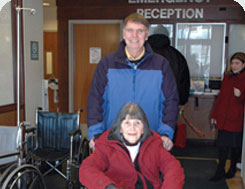"If just one symptom shows itself, call 9-1-1 immediately." -Rao
Pasupuleti, MD, medical director of RWJ Hamilton's stroke program

The human body may endure decades of obesity, heart disease, diabetes, high blood pressure, or smoking and drinking — all major risk factors for strokes. Then, suddenly, with little warning, everything changes.
| Meet Eve Fleming of Plumsted Like many women, Eve Fleming takes an anticoagulant drug to manage her cardiovascular disease. “I was having nosebleeds so I stopped my Coumadin,” the Plumsted resident recalls. “That was a big mistake.” Fleming’s arterial fibrillation (irregular heartbeat) — a condition that makes her five times more likely to experience stroke — eventually caused three consecutive strokes. “All of a sudden I felt dizzy. My left side was droopy and I called my husband Joe for help,” she recalls. A few months earlier, Joe read an article about stroke in the Trenton Times. “I knew I had to call 9-1-1,” he said. “When the ambulance arrived I asked them to come here because she needed the best. It was a little further than they’re used to but they did it.” When Fleming arrived at 2 p.m. she was weak and unable to swallow. Within 15 minutes, her CAT scan was completed and read. As time passed, her condition worsened: her speech was slurred and her body more lethargic. “I was worried,” says Joe. “I knew she needed that drug within three hours.” Shortly after an hour Eve was administered the lifesaving t-PA by Rao Pasupuleti, MD. “Twenty minutes later our daughter arrived in the ED and she didn’t see any of the signs I saw. It was an amazing turnaround,” Joe says. “As in Mrs. Fleming’s case, successful treatment with t-PA depends on two factors: prompt recognition of stroke and treatment at a stroke center,” says Pasupuleti. Now, the mother, grandmother and wife of fifty years to her beloved Joe, resumes her life. Joe beams. “I like to tell her it was our daughter that made her better.” |
“Simply stated, a stroke is a brain attack. It is caused by either a clogged artery that prevents blood flow to the brain or a blood vessel erupting in the brain. Without oxygen-rich blood, brain cells begin to die, causing stroke” says Rao Pasupuleti, MD, medical director of RWJ Hamilton’s stroke program. “When someone experiences this attack, every second counts,” he adds. That’s why
RWJ Hamilton created a 24-hour rapid response team trained to treat stroke victims as quickly as possible.
Pasupuleti, a board certified neurologist and clinical neuro-physiologist, cautions
“If just one symptom shows itself, call 9-1-1 immediately.” EMTs know that time is critical — and rushing a patient to a certified stroke center such as RWJ Hamilton can make the difference. When a stroke victim is en route to the emergency department, the team is mobilized. Upon arrival, physicians assess the patient’s condition and stabilize him or her. A blood sample is sent to the lab for evaluation.
Meanwhile, a CT scanner creates three-dimensional pictures of the brain, enabling doctors to determine appropriate treatment.
Treatment After Stroke
A stroke caused by a blood clot plugging an artery in the brain is called an ischemic (is-ke-mik) stroke. The neurologist may choose to use a drug called tissue plasminogen activator (t-PA); this drug breaks up clots blocking blood flow in the brain and allows oxygen and essential nutrients to return to the affected area. To be effective, t-PA must be administered through an IV within three hours of the stroke.
Treatment doesn’t end in the emergency room. The new dedicated stroke unit includes heart monitors in each specially-designed room. Here, physicians and the stroke team — led by Stroke Program Coordinator Johanna Demirjian, a neuroscience nurse practitioner — follow patients through their entire stay. Stroke patients are examined by a physical therapist within 24 hours, and are then seen by an occupational therapist and speech therapist. “The coordination of medical and rehabilitation services is the key to resuming life,” says Demirjian. “That’s why we’re here — to restore quality of life.”
After leaving the hospital, many survivors work to overcome disabilities with the help of caregivers and RWJ Hamilton rehabilitation therapists. For some it’s a shorter journey, yet others work years to overcome memory loss, aphasia and physical challenges. “In our stroke support group, we talk about how to take this journey one day at a time,” says Demirjian. “It’s inspiring to see our patients come so far.”
WOMEN AND STROKE
Take Note
- Cardiovascular disease, which includes heart disease and stroke, is the number one killer of women.
- More women than men die from strokes.
- African American women have a significantly higher risk of stroke.
Know Your Risk
- Your risk doubles if an immediate family member has suffered a stroke.
- High blood pressure.
- Birth control pills and pregnancy increase risk.
- Using hormone replacement therapy to relieve menopausal symptoms.
- A large waist and high body fat level.
- Migraines raise your risk 3 to 6 times.
BE STROKE SMART.
Recognize the Warning Signs.
- Numbness or weakness in the face, arms or legs.
- Confusion; trouble speaking or understanding speech.
- Loss of vision in one or both eyes.
- Dizziness, or trouble walking.
- Severe headache.